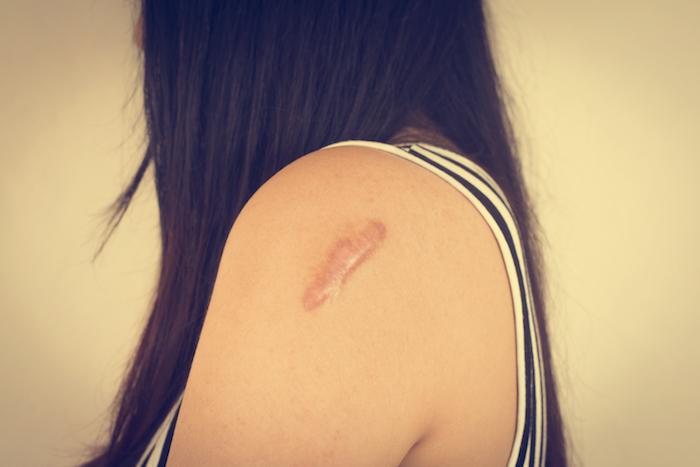We all get hurt, and we all heal. But healing leaves scars. These are facts we rarely question unless we have been saddled with a really ugly scar in a prominent place. It begs the question: What are scars, and why do people get them? Why do some people get more scars than others, and why do some places scar more easily? To get these answers, let’s take a look at the healing process and why it makes scars.
Everybody Scars
All mammals scar. Well, almost. Embryonic mammals don’t scar at all. If, for example, a doctor performed surgery on a baby in the womb, the suture line would heal, and the baby would be born with no scar at all. This is because the embryonic cells repair the area in the same way they make new cells. This shows us clearly that there is a difference between normal skin cells and scar cells.
Scar Cells: Vive le Difference
Skin isn’t just there to make you look good. When you damage your skin, you are damaging the largest organ in your immune system. You open your entire body to bacteria, fungi, and parasites. Although we know to wash a wound, keep it clean and bandaged, and perhaps even use a little antibacterial ointment, our ancestors didn’t. For millennia, humans just had to cope with injuries and hope for the best. Our bodies adapted to help us survive. So, when we broke the open skin, our cells went into overtime, creating new cells quickly to cover the open area. These cells aren’t perfect copies. It’s like the difference between taking 15 minutes to decorate the perfect cupcake and taking 30 seconds to smear some icing across the top. Both cover the cupcake, but one looks better.
Types of Scars
Our skin repairs itself in a variety of ways. As a result, there are many different kinds of scars. If we were given preference, we’d all wish for smaller, fine scars. These are thin, flexible scars that are difficult to see and often resolve over time. Stretched scars are exactly what they sound like. These are scars that were stretched as they healed. Consequently, they are wider than fine scars. But they are smooth and flexible. Many people see atrophic scars after a bad case of acne or chickenpox. These scars are indentations in the skin, like little pock marks. Hypertrophic scars are the exact opposite. These are scars that rise above the surface of the skin. Both atrophic and hypertrophic scars stay within the boundary of the original wound.
The last two types of scars are the hardest to deal with throughout life. Contracture scars are hypertrophic scars that happen along a joint. They are called “contracture” because they tend to contract the joint, limiting movement. Keloids are the final type of scarring. This is wildly massive hypertrophic scarring that goes beyond the boundaries of the original wound. The person who suffers from a keloid scar may have a simple insect bite and wind up with a raised scar several inches in diameter.
Location, Location, Location
When it comes to scarring, where it occurs matters. If the wound happens in an area that has thin skin and doesn’t move a lot, there will be minimal scarring. However, a wound in an area that moves is far more likely to scar. So a cut just behind the ear will heal more smoothly than a cut in the middle of your chest. Think about it, when was the last time you accidentally wiggled your ears. On the other hand, you can’t move your arms or turn your head without disturbing the skin on your chest.
What Can You Do?
You can’t stop all scarring, but there are things you can do to reduce them. First of all, have any significant wound checked by a doctor. Stitches can help minimize the risk of scarring. Next, use bandages to help hold the skin steady while it’s healing. This might be butterfly bandages or other skin adherent tapes. Finally, if you have a scar that bothers you, don’t try to just live with it. Make an appointment to see your dermatologist. There are a variety of treatments to remove or reduce the appearance of all types of scars, including keloids. Dr. Bopp uses a wide range of techniques to get your skin back in the pink.
Scar Revision available at Bopp Dermatology & facial plastic surgery by Dr. Felix Bopp may be required to enhance the treatment results of the recommendations below. Scars cannot be completely removed. However, thanks to breakthroughs in technology, in most cases their appearance can be dramatically minimized. Depending on the type of scar you have, one or more of the following treatments may be used:
- Scar revision with Dr. Felix Bopp the Facial Plastic Surgeon
- Injection with 5FU/ Kenalog is often combined with laser treatments to speed resolution of the scars.
- Topical treatments such as Stratamed or Strataderm which can be purchased at our online store https://store.boppskin.com/collections/anti-scarring . Stratamed a topically applied silicone gel that is used on abrasions, small superficial lacerations to hasten healing to prevent scarring. Strataderm is a topically used silicone gel used on red scars to decrease redness and any thickened areas.
- Excel V and Laser Genesis are laser treatments that reduces redness and any thickened area within the scar
Please schedule an appointment with one of the providers at Bopp Dermatology & Facial Plastic Surgery in Metairie to learn which product and laser is best for you.


